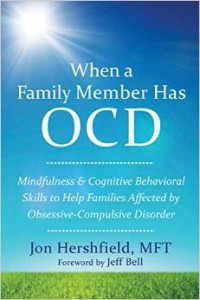Hi, my name is Bowen. I’ve suffered from Obsessive-Compulsive Disorder for over 5 years now. I had to give up my dream, my school, my hobbies and more to this horrific yet underrated disease. So as I recover, I decided to use my own experiences to help others suffering from the same disease or basically all mental illnesses. The current issue with the way major mental health foundation is that they don’t use the power of Internet to the full extent. Often, they have websites with bad design and no online events at all. Some of them joined social media but still try to raise awareness through the old-fashioned way. So that’s why started OCD Acceptance, using my programming and technology skills, I’m taking the advantage of Internet to help as many people out there as I can.
Cognitive Therapy in OCD: Treatment for Taboo Thoughts
This blog post is based on a paper I recently published with my colleagues at MGH, in which we described the rationale and the procedures for conducting cognitive therapy in the treatment of OCD. My goal for this post is to briefly describe the similarities and differences between cognitive therapy (CT) and exposure and response prevention (ERP), and explain how it can be used in the treatment of unwanted taboo thoughts.
ERP and CT are both evidence-based psychological treatments for OCD. Both are cognitive-behavioral treatments for OCD, which have garnered significant research support for their efficacy and effectiveness. Despite this, ERP and CT have slightly different explanations for how they are thought to improve OCD symptoms. ERP is based on the theoretical principle that avoidance behaviors and compulsive rituals (that aim to provide relief from anxiety in the short-term) interfere with people’s ability to learn safety and tolerate uncertainty. As a result, ERP relies on the use of exposures, which are designed to help patients confront their feared situations. In contrast, CT is based on cognitive models of OCD, which propose that maladaptive beliefs and interpretations about one’s unwanted intrusive thoughts play a role in the development and maintenance of OCD symptoms. As a result, CT relies on the use of behavior experiments, which are designed to gather information and test hypotheses about feared consequences. Whereas exposures are thought to work by helping patients habituate to anxiety levels, behavior experiments are thought to work by helping patients evaluate and challenge their faulty thinking. Thus, in theory, exposures and behavior experiments diverge on the basis of the proposed mechanism of action underlying OCD symptom improvement. In practice, however, I often find it to be the case that patients challenge their thinking through both behavior experiments and exposures, which explains why some clinicians use the terms exposures and behavior experiments synonymously.
For treating unwanted taboo thoughts in OCD, CT offers an important treatment alternative for patients who are unwilling to do exposures. CT strategies involve a systematic approach to identifying faulty thinking patterns that are labeled as OCD, as well as steps to evaluate their validity and generate more balanced beliefs. These techniques include the courtroom technique, continuum strategy, role plays, conducting a survey, consulting an expert, and downward arrow exercise. Why the emphasis on changing thoughts? It is a core tenet of CT that thoughts impact feelings (e.g., anxiety) and ultimately people’s behaviors. Many of my patients have experienced unwanted, intrusive, taboo thoughts about saying or doing something morally or sexually inappropriate, or accidentally hurting (emotionally or physically) others or loved ones. One of my patients had fears about being a pedophile even though she was completely disgusted by the thought and would never hurt a child. We conducted behavior experiments to test out her predictions about what would happen (and whether she could tolerate her anxiety) if she were to look at small children in the eyes, or even babysit for her nephews and nieces. Another one of my patients believed that his rituals prevented bad things from happening to his family, so we conducted a behavior experiment to curse a family member during one of our sessions while withholding rituals. In addition to a line of questioning in our sessions about how could he possibly hold such power and responsibility for preventing harm, he was able to reframe his thinking to let go of his rituals. Although taboo thoughts are sometimes the hardest to let go, they are totally treatable, and CT strategies are a highly therapeutic treatment alternative or complement to ERP.
For more information about CT for OCD, please see our original article:
Berman, N. C., Fang, A., Hansen, N., & Wilhelm, S. (2015). Cognitive-based therapy for OCD: Role of behavior experiments and exposure process. Journal of Obsessive Compulsive and Related Disorders, 6, 158-166.
‘Twas an OCD Night Before Christmas”: A Christmas Poem
By Melanie and Brandon Lefebvre
‘Twas the night before Christmas,
when all in my head,
The thoughts they were stirring,
while I lay in my bed.
The stockings weren’t hung,
by the chimney with care,
To ensure that both cats,
come morning were there.
The kitties were nestled,
all snug on the bed,
While visions of death,
danced in my head.
With Clive all curled up,
and Doug on my lap,
I had trouble settling in,
for a long winter’s nap.
While up in my mind,
the thoughts wouldn’t scatter,
The doubt and the fear,
just went pitter patter.
I ran down the stairs,
in a midnight mad dash.
The compulsion to check,
had spread like a rash.
Had I put them away?
I just had to know.
Could they be on the mantle,
just left out for show?
Approaching the chimney,
it soon became clear.
My OCD fooled me,
I succumbed to the fear.
The stockings were stored,
yet again I’d been tricked.
And doubting my actions,
had made me feel sick.
I returned to my bed,
all ridden with shame,
When checking you know,
OCD is to blame.
Now down again, up again,
Checking left me unsure,
With all of this doubt,
I hoped for a cure.
OCD was convincing,
of that I won’t lie.
I’d grown tired of fearing,
that my cats could die.
Maybe come morning,
it was time for a call,
To get peace from a therapist,
once and for all.
—
Special thanks to my husband and the poem “A Visit from St. Nicholas” by Clement Clarke Moore (1823). Following the poem’s format was a fun way to spread OCD awareness together.
Merry Christmas to all and to all a good night!
Melanie, Brandon, Clive and Doug
How Much Can Change For the Better in a Year
This post comes from our regular contributor, Melanie Lefebvre. Here she writes about her experience attending the International OCD Foundation’s Annual Conference in Boston last year, and this past July. She wrote about her hit and run OCD in an earlier article.
Rewind to 2014 at the International OCD Foundation’s Annual OCD Conference. Zoom in to me volunteering to share my struggle with hit-and-run OCD at Dr. Baer’s workshop about taboo thoughts. Adjust the lens and you’ll see that it was a period of my life where I had stopped driving out of fear of accidentally hitting someone. It wasn’t worth the risk. Driving was paused as I hung out with the comfort of avoidance. But after his workshop, I decided the risk was worth it. Being Dr. Baer’s impromptu patient got me back behind the wheel.
 Now fast forward to the OCD Conference of 2015. I again attended his workshop on taboo thoughts but this time observed a peer share her story—now a witness to the vulnerable place I was in just a year prior. The audience again created a sense of community. The community who helped hold me accountable to my commitment to drive again; the community that Dr. Baer introduced me to. By asking for a volunteer that day, Dr. Baer helped me decide I wanted back in the driver’s seat.
Now fast forward to the OCD Conference of 2015. I again attended his workshop on taboo thoughts but this time observed a peer share her story—now a witness to the vulnerable place I was in just a year prior. The audience again created a sense of community. The community who helped hold me accountable to my commitment to drive again; the community that Dr. Baer introduced me to. By asking for a volunteer that day, Dr. Baer helped me decide I wanted back in the driver’s seat.
But it’s not just the driving that’s changed.
Last year, I almost didn’t attend the conference out of fear my cats would die without doing my compulsions to keep them protected. This year, I trusted in my husband to care for them.
Last year, I bawled in the airport lobby, contemplating not getting on the plane. This year, I sat calmly in the lobby and realized Brave by Sara Bareilles was playing.
Last year, I requested photos of my cats as proof of life while away. This year it didn’t even occur to me to ask for pictures.
Last year, I disclosed to my mom about my OCD only a few months prior. This year, I felt pride in my video in which I disclosed to anyone who might stumble across it on YouTube.
Last year, driving was impossible. This year, I’m driving.
The conference wasn’t a magical fix. Driving is still hard. OCD is still hard. Sometimes I don’t want to get behind the wheel. But I’m viewing the conference as the renewal of my commitment to the community.
Here’s to 2016 in Chicago, next year’s conference, where I again “renew my vows” to progress!
Note: The photo shows me with Dr. Baer
Peer Support Forums: Announcement
This year, we explored the addition of peer support forums to our website. We are always trying to improve our peer support services and adapt to what is needed. After a trial run of the forums, we have concluded that peer support forums on our website are not the best way to meet the needs of the community.
We’ve decided to put these forums on hold for the time being, and allocate our resources into matching individuals up for one-on-one support. This can be done via email and/or phone and can be confidential, if desired. In addition to peer support, you’ll have access to experts in the field–this can be especially helpful for questions peers aren’t qualified to answer, such as issues with medication or referrals.
We hope this will be of help to you and please stay tuned for more details. If you are interested in participating, please use the “I’m interested in one-on-one peer support for unacceptable intrusive obsessions”contact form in the “Peer Support” menu and let us know.
Advice for Family Members of OCD Sufferers
 Jon Hershfield, MFT is a psychotherapist in private practice who specializes in the treatment of obsessive compulsive disorder (OCD). His most recent book, When a Family Member Has OCD, foreword by Jeff Bell, will be available on December 1st, 2015 here. Here is an article he wrote for us:
Jon Hershfield, MFT is a psychotherapist in private practice who specializes in the treatment of obsessive compulsive disorder (OCD). His most recent book, When a Family Member Has OCD, foreword by Jeff Bell, will be available on December 1st, 2015 here. Here is an article he wrote for us:
To Be a Truly Significant Other to an OCD Sufferer
It’s not unusual at some point in individual treatment for me to have my OCD client bring in a family member or significant other. Though OCD can make you feel alone in the universe, consistently surprised that most people don’t seem to think the way you do, the struggle doesn’t exist in a vacuum. Decisions people make in how they respond to unwanted thoughts cause ripple effects to throughout the family system. In other words, what you do, may affect what I do to someone else, who in turn may behave differently toward another and so on.
The first thing I ask the significant other in the session is, why is this person in therapy, do you think? What are they doing, what are you seeing, that is leading to the rational conclusion that this person needs help in the first place? The answers range from the obvious (she washes her hands all the time) to the heartbreaking (he won’t stop bothering me with confessions I don’t want to hear!). But the most common thing I hear from family members is something like, She’s in her head all day and I can just tell some thing is wrong. Family members of OCD sufferers often find themselves juggling a series of chainsaw-like considerations. If I’ve given him all he wants, why does he keep asking for more? If I stop giving him what he wants, how can I cope with his desperation? How can I reduce his suffering? Damned if you do, damned if you don’t. But this is due in large part to lacking insight and understanding into the mind of an OCD sufferer.
In my new book, When a Family Member Has OCD, I set out to achieve two objectives. First, I wanted there to be an empathy guide for family members of OCD sufferers. The biggest problem I find in OCD families is often the easiest address – they just don’t get it because no one’s ever really broken it down for them in a language that they speak. All of this psychological mumbo-jumbo (as it appears to them) can often just lead to the conclusion that the OCD sufferer is sick or broken. In fact, the OCD sufferer has a common, difficult, yet treatable mental heath challenge that simply distorts the way thoughts and feelings are looked at and then responded to. Second, once empathy in the family is maximized as best it can be, I wanted there to be some basic guidelines available for helping family members support each other without having to become each other’s therapist. To do this, I wrote a sort of roadmap to approaching the OCD sufferer, one that can encourage openness to being helped and interest in helping themselves in the family context. The four I’s discussed are:
Identify the compulsion, not the person, as the problem: Family members need to be able to differentiate between something a loved one is doing in response to unwanted thoughts and something a loved one is doing because they simply feel like it or it suits their personality. Conflict immediately arises when delays, requests for accommodation, or just confusing behavior gets attributed to one’s character instead of being understood within the context of OCD. If families can come together to support one another in navigating this disorder, it all hinges on this first step of seeing the disorder and the person as not being one and the same.
Invite collaboration: Building on the awareness that compulsions are the problem, not people, families can come together to strategically target the OCD at home. But this has to be done in the spirit of teamwork, not oppression. Getting family members and their loved ones with OCD on the same side against the disorder takes a special kind of effort. Approaching an OCD sufferer with a simple mandate to “get over it” or “get it together” does little to change the grip OCD has on the family. The key to inviting positive change is making a better offer than the OCD, not just another threat.
Interrupt the obsessive-compulsive cycle (with permission): Cognitive behavioral therapy (CBT), mindfulness, and exposure with response prevention (ERP) are effective interventions in the battle against OCD. Once an agreement to collaborate among family members has been achieved, more concrete interventions can be implemented. Accommodation of compulsions can be gradually reduced, as can reassurance-seeking/giving. Increasingly straightforward blocking strategies can be implemented to reduce physical compulsions (such as checking and washing). Contracts for how to deal with OCD-related behaviors can be drawn up and followed. All of this is possible when roles are made clear.
Integrate and model healthy behaviors: As compulsions are reduced and mastery over the disorder continues to develop, pockets of family life that had been filled with OCD symptoms will rather abruptly become empty. Families paying the right kind of attention to this can fill these voids with healthy behaviors, healthy communication, and healthy modeling for one another. This can be enhanced by family members without OCD challenging themselves to accept uncertainty, expose to fears, observe their own thoughts with less judgment, and basically get a taste of what their loved one is putting so much effort into.
None of these guidelines are meant to replace professional help. In fact, in most cases I suspect they will lead to the conclusion that the right kind of professional help is something feasible and worth pursuing. For this reason I included a section of When a Family Member Has OCD covering some of what to expect when seeking professional help. I also had the opportunity to include in the book a lot of do’s and don’ts that apply specifically to different family dynamics. Relating to a parent who has OCD and trying to understand a sibling with OCD are not the same. How it affects you, what’s expected of you, what you can do to help take care of yourself as well as your loved one – all of this is colored by the specific relationship dynamic.
OCD is a painful and frustrating disorder, but when a family can come together to overcome it, the journey often brings about an unparalleled trust among loved ones and with it, a brighter, happier family system.

